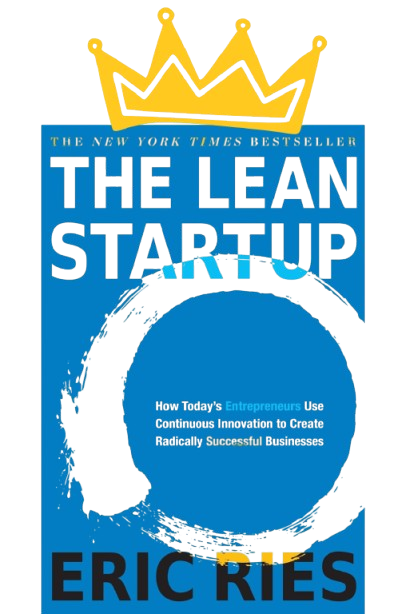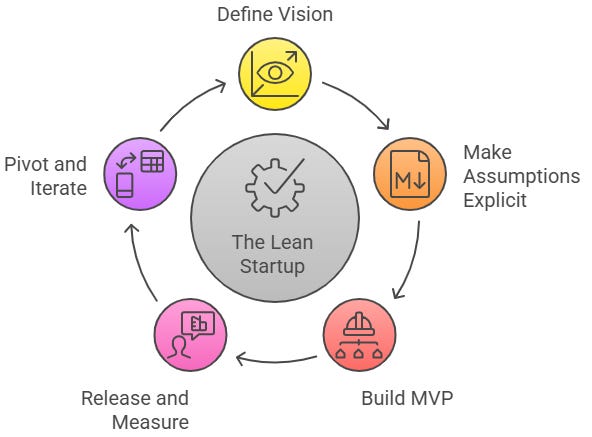The Lean Startup: What You Can Actually Learn From the King of Founder Books
This Friday->The Lean Startup: How Today's Entrepreneurs Use Continuous Innovation to Create Radically Successful Businesses by Eric Ries [5 min reading]
On Startup Salad I break down a business book’s key takeaways in a simple, digestible format, just like a good salad!
Hey, it’s Fede!
LADIES AND GENTLEMEN...
After 29 newsletters on business books for founders...
It's time for the UNDEFEATED CHAMP.
The top pick of every startup advisor.
From Silicon Valley…
With over ONE MILLION COPIES SOLD
336 pages of pure startup knowledge,
Published in 2011, still running the game.
Written by the one and only…
ERIC RIIIIESSSS!
THIS IS…
THE LEAN STARTUUUUUUUP!
Today's book: The Lean Startup: How Today's Entrepreneurs Use Continuous Innovation to Create Radically Successful Businesses by Eric Ries
This intro had to be moderate. We're about to talk about the holy scripture of wannabe founders.
I’ve read it multiple times, at very different moments in my life. Sometimes I loved it, other times... not so much.
Let’s break it down and see what’s still worth keeping today.
Corporate Rules Don’t Work Here. Here’s Why.
The core idea is simple: there’s traditional management (for big corporates)… and then there’s startup management also known as "being an entrepreneur".
Why the distinction?
Because building a startup isn’t just business… it’s almost a belief system.
And the difference becomes clear with Eric's definition:
"A startup is a human institution designed to deliver a new product or service under conditions of extreme uncertainty."
That last part extreme uncertainty changes everything.
Forget "a young company that's highly scalable". Eric wants us to focus on the chaos. And in chaos, traditional management fails miserably.
And honestly?
He’s right.
I’ve seen it myself, traditional consultants giving advice to founders that made zero sense (and sometimes real damage).
That’s why Eric developed the Lean Startup method.
And like it or not, it’s become the default playbook for how we build startups today.
The MVP (minimum valuable product) isn’t What You Thought It Was.
The key question the Lean Startup methodology tries to answer is not "what can we build?" but rather: "what should we build?"
To answer this, Eric Ries built a framework around a now OVERUSED but still crucial word:
PIVOT.
Honestly, at this point, even breakups might start being called "pivots to a new partner."
Buuuutt…jokes aside, the concept is still valid.
Here's the Lean Startup System, divided in simple steps for you:
Step 1: Define your vision and your goal
Write down your idea. Or to sound fancier, your vision.
So far, so good.
Now: set a measurable goal. THIS IS VERY IMPORTANT.
Example: "In this cycle, I want at least 10% of users to download the brochure."
Here the list of key KPIs you can keep track of:
Activation: are people actually using it?
Retention: do they come back?
Referral: are they telling others?
Revenue: are they paying or just clicking?
Please, ignore vanity metrics.
Without a goal, there's no test. And without a test, there's no learning.
Step 2: Make your assumptions explicit
Writing down your idea means you’re implicitly making assumptions. Now turn those into explicit hypotheses. If you want to know more about hypotheses, click here.
Step 3: Build an MVP (a real one)
This is where most founders mess up.
Everyone thinks MVP = a product with enough features to convince someone to pay. But again, Eric doesn’t agree.
Your MVP should include only the essentials that let you validate your core assumptions. Nothing more.
Two types worth trying:
Concierge MVP: Fake the automation. Make it look like a real product, but do everything manually behind the scenes. Eric once tested a shoe e-commerce this way: when someone bought, he physically went to a store, bought the shoes, and shipped them.
It worked. And no one noticed.
Smoke Screen MVP: Pretend it exists, but it doesn’t, yet. Create a landing page, a brochure, a "Buy now" button that doesn’t do anything, or a fake demo video. What matters is the signal, not the software.
Now with AI, MVPs can be done more easily. But the mindset stays the same: build to learn, not to launch.
Step 4: Release and measure what matters
Here’s where it gets real.
You can either:
Run targeted ads to test reactions
Reach out directly to people who might care
To be honest, this part is hard, veeery hard.
If you’re starting from scratch, with no budget and a weak MVP, finding your first users is brutal.
My tip?
If you can, start in a space you already know. It’s way easier to talk to users if you understand their world.
If not, cold emails and LinkedIn DMs can work… but good luck if the sector’s totally unfamiliar.
As for ads: they can still work well if you know what you’re doing. Study first. Even with a small budget, you can learn a lot.
Step 5: Pivot and go again
This is the heart of the Lean Startup method.
Back in Step 1, you set a goal. Now look at the results.
Did you miss the mark? Good, that’s the point. If you’re hitting every goal, you’re aiming too low.
Each loop should help you get closer to something that works. If it doesn’t, your idea might be broken.
Time to pivot. And launch the next cycle, meanwhile you are growing a bit every time.
That’s how real progress happens: not in straight lines, but in fast, smart loops.
Quick reminder from Eric:
Vision = don’t touch it (it’s your why)
Strategy = can change (it’s your how)
Product = must change (it’s your what)
Final Personal Considerations
The system works, that’s why it’s used so much.
What I really like is that it tries to solve the biggest startup problem: building things no one actually needs.
But there are two real challenges.
First: finding users to run tests on is hard.
You need volume. You can’t pivot based on what three random people say. That’s just noise.
Second: choosing what data to track isn’t easy.
It sounds simple, but setting the right metrics is tough.
And if you get that part wrong, the whole system breaks. Bad data means bad learning, which leads to bad decisions.
That said, I really believe this book is worth reading.
More than once. It hits differently at different stages of your founder journey.
That’s it for today, I hope you enjoyed it, BIG HUG.
The guidelines you need to build your startup:
See you next Friday,
Federico Lorenzon








